Transvaginal Mesh Lawsuit
- Last Updated: June 24th, 2025

Attorney Jessica Paluch-Hoerman, founder of TruLaw, has over 28 years of experience as a personal injury and mass tort attorney, and previously worked as an international tax attorney at Deloitte. Jessie collaborates with attorneys nationwide — enabling her to share reliable, up-to-date legal information with our readers.
Legally Reviewed
This article has been written and reviewed for legal accuracy and clarity by the team of writers and legal experts at TruLaw and is as accurate as possible. This content should not be taken as legal advice from an attorney. If you would like to learn more about our owner and experienced injury lawyer, Jessie Paluch, you can do so here.
Fact-Checked
TruLaw does everything possible to make sure the information in this article is up to date and accurate. If you need specific legal advice about your case, contact us by using the chat on the bottom of this page. This article should not be taken as advice from an attorney.
Key takeaways:
- Transvaginal mesh lawsuits focus on patients who have experienced serious complications from surgical implants. Victims can sue the manufacturer for issues like design defects or lack of warnings.
- Anyone harmed by a transvaginal mesh implant may be eligible to file a lawsuit. Lawyers help victims build strong cases against manufacturers.
- Current litigations, such as those in West Virginia and multidistrict litigation for ObTape brand, highlight the growing concerns over these implants' safety.
- To qualify for a transvaginal mesh lawsuit, certain criteria need to be met including proof of harm caused by the implant and medical documentation supporting related health issues.
- Recent settlements involving major manufacturers provide hope for victims seeking justice. The compensation varies based on injury severity and case specifics.
What is the Transvaginal Mesh Lawsuit?
Question: What is the Transvaginal Mesh Lawsuit?
Answer: Transvaginal mesh lawsuits have been filed nationwide by women who claim that defective surgical mesh implants caused severe health complications, such as recurring infections, organ perforation, and internal bleeding that often required patients to endure multiple revision surgeries.
Our law firm is actively assisting individuals with transvaginal mesh lawsuit claims across all fifty (50) states in the United States.
This page provides the most recent news and updates on transvaginal mesh lawsuits and expert insights on potential settlement amounts that plaintiffs with transvaginal mesh lawsuits could receive.
You will not get more updated news on vaginal mesh lawsuits anywhere else.
On this page, we will provide an overview of the transvaginal mesh lawsuit, eligibility criteria to file a transvaginal mesh lawsuit, types of damages cause by surgical mesh, and much more.

Transvaginal Mesh Lawyers Holding Manufacturers Accountable
The lawsuits center on serious design defects in transvaginal mesh products that made them inherently dangerous for patients by degrading inside the body over time, becoming rigid, and harboring harmful bacteria due to their porous design.
Legal experts are investigating the adequacy of these manufacturers’ design and testing practices following the FDA’s issuance of multiple safety warnings and re-classification of transvaginal mesh products in 2016.
While many cases have been resolved, individual claims can still be filed today.
If you or someone you love has experienced complications with your transvaginal mesh implant, you may be eligible to seek compensation.
Contact TruLaw using the chat on this page to receive an instant case evaluation that can determine if you qualify to join others in filing a transvaginal mesh lawsuit.
Table of Contents
Transvaginal Mesh Lawsuit Updates Timeline
Midurethral mesh slings, commonly used to treat stress urinary incontinence (SUI), have come under increasing legal and medical scrutiny due to serious complications reported by thousands of patients.
Complaints such as chronic pain, infections, mesh erosion, and organ perforation have led to growing concerns about the safety and design of these surgical implants.
New research published in the Applied and Environmental Microbiology journal in June 2025 offers fresh insight into the potential biological causes behind these issues.
The study found that the bacteria colonizing the mesh slings differ significantly from the typical microbial populations found in nearby vaginal, urinary, and skin environments.
In particular, mesh samples from patients with chronic pain showed greater bacterial diversity, including the presence of species such as Enterococcus—suggesting a connection between mesh-specific bacteria and inflammatory complications.
These findings support claims made in numerous lawsuits against mesh manufacturers.
Plaintiffs allege that the devices are defectively designed in a way that fosters harmful bacterial colonization and that companies failed to adequately warn patients or conduct sufficient premarket testing to uncover long-term health risks.
Legal actions seek compensation for a range of damages, including medical costs, lost wages, pain and suffering, and diminished quality of life.
As more scientific evidence emerges, the role of microbial colonization is becoming a key element in both understanding mesh complications and holding manufacturers accountable.
A new study published in Nature Reviews Urology has found that microscopic particles from transvaginal mesh (TVM) implants may trigger autoimmune responses, even after the device has been surgically removed.
The research, led by Dr. Nicholas Farr, links residual polypropylene particles—commonly used in mesh products—to Autoimmune/Inflammatory Syndrome Induced by Adjuvants (ASIA).
According to the study, these particles can remain in surrounding tissue and provoke ongoing immune system activity, potentially worsening symptoms long after mesh removal.
These findings may impact current and future transvaginal mesh lawsuits by challenging earlier conclusions that dismissed any association between mesh implants and autoimmune disease.
In particular, the new evidence calls into question a 2017 study published in the American Journal of Obstetrics and Gynecology, which found no systemic health risks related to mesh use.
The U.S. Food and Drug Administration (FDA) announced a proposal to reclassify transvaginal mesh used for treating pelvic organ prolapse (POP) as a high-risk medical device.
If the proposal is finalized, manufacturers will be required to provide comprehensive data on the product’s safety and effectiveness before it can be marketed.
In addition to reclassifying the mesh itself, the FDA is also seeking to elevate the regulatory status of the surgical instruments used to implant and secure the mesh—from low-risk to moderate-risk—reflecting the growing concern over potential complications.
This move follows more than a decade of increasing scrutiny.
The FDA first flagged potential safety issues with vaginal mesh products in 2008 and later issued formal warnings and postmarket surveillance requirements in 2011 and 2012.
The proposed changes are now open for public comment for a 90-day period.
It’s important to note that these reclassifications apply only to mesh intended for vaginal POP repair and related tools; devices used for hernia repair, stress urinary incontinence, or abdominal POP procedures are not included in the proposal.
Transvaginal mesh (TVM) implants were introduced in the late 1990s as a solution for pelvic organ prolapse (POP) and stress urinary incontinence (SUI).
Intended to reinforce weakened pelvic tissues, these devices quickly gained popularity—but over time, they became linked to serious and often debilitating complications, including chronic pelvic pain, organ perforation, bleeding, and mesh erosion.
These complications have triggered a wave of litigation against mesh manufacturers, as thousands of affected women have sought accountability and compensation.
Resolution of Federal MDLs: A Major Milestone
To manage the sheer volume of cases, many lawsuits were consolidated into multidistrict litigations (MDLs), streamlining the legal process while enabling more efficient case resolution.
The final federal MDL for transvaginal mesh concluded in November 2022, with numerous claims settled during the proceedings.
However, the end of the MDL does not prevent individuals from filing personal lawsuits.
Women who have experienced mesh-related injuries can still bring individual claims tailored to their specific circumstances.
Why Individual Claims Still Matter
Pursuing a separate lawsuit outside the MDL framework offers several potential advantages:
- Customized Legal Strategy: Each case can be evaluated independently, allowing for personalized legal approaches and negotiation tactics.
- Higher Compensation Potential: Individual cases are not bound by MDL settlement averages, which may lead to greater financial recovery based on the severity of the injuries.
- Greater Plaintiff Control: Those pursuing individual claims often have more input over critical decisions, such as trial participation and settlement acceptance.
Even with many high-profile settlements behind them, manufacturers continue to face litigation.
For example, Johnson & Johnson agreed to a $120 million settlement in January 2016 to resolve around 3,000 claims.
Yet, many lawsuits remain active, with both federal and state courts still handling unresolved cases.
In August 2024, 140 women in the UK received compensation for injuries linked to vaginal mesh implants.
The claims targeted major manufacturers, including Johnson & Johnson, C.R. Bard, and Boston Scientific, and involved complications such as persistent pain, organ perforation, and mesh migration.
Women considering filing a lawsuit related to transvaginal mesh injuries should keep the following in mind:
- Statute of Limitations: Deadlines for filing vary by state and country. Prompt legal consultation is crucial to avoid missing these time-sensitive windows.
- Medical Documentation: Clear medical records linking the mesh implant to resulting health problems will strengthen a case.
- Specialized Legal Support: Working with attorneys experienced in mesh litigation can significantly improve a claimant’s chance of success.
Despite the closure of the federal MDL, transvaginal mesh litigation remains active and evolving.
Women who continue to suffer from complications should explore their legal options, especially as new studies and settlements highlight the ongoing impact of these devices.
Let me know if you’d like this turned into a landing page, newsletter piece, or formatted infographic summary.
An Oregon jury has ruled in favor of the defense in a medical malpractice lawsuit involving the implantation of a pelvic mesh device.
The plaintiff accused urologist Dr. Michael Lemmers and the Legacy Health hospital system of negligence, alleging they failed to obtain proper informed consent before implanting the Boston Scientific “Uphold Lite” mesh device during a 2019 procedure to treat pelvic organ prolapse.
The case focused on claims that the patient was not adequately informed of the potential risks associated with the device.
Informed consent cases, particularly in the context of complex medical procedures, are notoriously difficult to win, and the jury’s decision reflects that legal reality.
New Mesh Lawsuits Continue Post-MDL Closure
Despite the formal closure of the vaginal mesh multidistrict litigation (MDL), new lawsuits are still being filed in state courts across the United States.
As of late 2024, legal efforts to hold mesh manufacturers accountable remain active, though outcomes have varied.
Internationally, the issue also persists.
In August 2024, more than 100 women in England received financial settlements for serious complications resulting from mesh implants.
Reported injuries included persistent pain, perforation of the bladder and bowel, bleeding, and mesh erosion through the vaginal wall.
While exact compensation amounts were not made public, the total reached into the millions of pounds.
Study Links Mesh Material to Rapid Degradation
Adding to the growing scrutiny, a recent study from the University of Sheffield in the UK has raised new concerns about the design and material quality of vaginal and pelvic mesh implants.
Researchers found that the plastic commonly used in these devices begins to degrade within just 60 days of implantation.
The study concluded that the material—widely believed to be biocompatible—may actually be prone to early breakdown, leading to inflammation, tissue damage, and long-term health complications.
These findings lend further support to ongoing claims that many mesh implants were fundamentally flawed in both design and manufacturing.
Groundbreaking research from the University of Sheffield has revealed significant flaws in the polypropylene (PP) material commonly used in transvaginal mesh (TVM) implants.
The study found that PP begins to degrade within just 60 days of being implanted, with further structural breakdown evident by 180 days.
This degradation, marked by oxidation and the buildup of polypropylene particles in nearby tissues, challenges long-held beliefs about the material’s chemical stability.
As the mesh deteriorates, it causes a growing disconnect between the implant and surrounding tissue, which can trigger inflammation, tissue damage, and chronic pain.
These findings call into question the overall biocompatibility of PP-based mesh devices, which have already been linked to serious complications such as pelvic pain, infections, and urinary problems.
The research adds scientific weight to the ongoing debate about the safety of these implants.
In response to mounting concerns, the NHS placed strict limitations on the use of TVM in 2018, allowing procedures only under a high-surveillance protocol.
The latest study further supports the claims of many women who have filed lawsuits after suffering long-term health issues from mesh implants.
In England alone, more than 100 cases have recently been resolved through settlements.
Advocates are now calling for urgent reforms and the development of safer, more sustainable materials to prevent further harm to patients undergoing treatment for pelvic organ prolapse and stress urinary incontinence.
Recent research has revealed that polypropylene—the primary material used in transvaginal mesh (TVM) implants—begins to break down within just 60 days of being implanted in the pelvic region.
This finding intensifies ongoing concerns about the long-term safety of TVM devices, which have been used to treat pelvic organ prolapse (POP) and stress urinary incontinence (SUI) but are linked to a range of serious complications.
Conducted by scientists at the University of Sheffield in the UK, the study used a sheep model, chosen for its anatomical similarities to the human pelvis.
Researchers discovered that polypropylene mesh became stiffer over time, exhibited signs of oxidation, and shed microscopic particles that were absorbed into the surrounding tissue—concentrations of which increased the longer the mesh remained implanted.
These results have sparked renewed calls from patient advocates and medical professionals for urgent reform.
Campaigners argue that the material was not sufficiently evaluated for pelvic use before being introduced into clinical practice.
Sheila MacNeil, an emeritus professor in biomaterials and tissue engineering, stressed the urgent need to develop safer alternatives to prevent further patient harm.
The study’s lead author, Dr. Nicholas Farr, expressed hope that the findings will encourage manufacturers to innovate and improve implant safety.
Meanwhile, Kath Sansom, founder of the patient advocacy group Sling The Mesh, cited the study as further proof of the dangers of polypropylene mesh and called for immediate changes in how pelvic conditions are treated.
This research follows a group settlement in which over 100 women in England received compensation after experiencing debilitating side effects from TVM implants.
Reported complications include chronic pelvic pain, infections, urinary difficulties, and the need for multiple revision surgeries.
The growing body of evidence has prompted medical and legal communities alike to push for stricter oversight, improved patient education, and the exploration of non-mesh alternatives for managing POP and SUI.
The Bard Hernia Mesh multidistrict litigation (MDL) has taken a significant step forward, with a major settlement bringing relief to thousands of affected individuals.
C.R. Bard has agreed to resolve the vast majority of claims filed in both the federal MDL and Rhode Island state court, settling more than 30,000 cases related to injuries caused by its hernia mesh products.
This marks a major conclusion to a lengthy and challenging legal battle that has been ongoing since the MDL was established in August 2018.
The litigation experienced delays due to the COVID-19 pandemic and a series of complex trials across multiple jurisdictions.
A turning point came in early 2024, when the MDL judge paused a planned bellwether trial and ordered the parties into mediation.
Following months of negotiations, the parties have now reached an agreement to compensate victims who experienced complications from Bard’s allegedly defective hernia mesh devices.
The settlement represents a substantial victory for plaintiffs and moves the litigation closer to closure for thousands of injured patients.
The United States Court of Appeals for the Eleventh Circuit has affirmed a lower court ruling in the case of Virginia Redding v. Coloplast Corporation, a significant decision in the ongoing litigation over vaginal mesh implants.
The appeal focused on whether Redding’s product liability claim was filed within the statute of limitations under Florida law.
Redding filed her lawsuit on September 18, 2014, asserting that vaginal mesh devices manufactured by Coloplast were defectively designed and caused her serious injuries.
Coloplast contested the suit, arguing it was time-barred due to Florida’s four-year statute of limitations for product liability claims.
The company claimed Redding began experiencing symptoms more than four years before initiating legal action.
However, the appellate court agreed with the lower court’s finding that Redding was not aware—and had no reasonable way of knowing—before September 18, 2010, that her injuries were specifically linked to the mesh implants.
As a result, the court ruled that her claim was timely.
The jury in the original trial awarded Redding $2.5 million in damages.
Coloplast’s post-trial attempt to overturn the verdict through a renewed motion for judgment as a matter of law was also denied by the district court.
This decision underscores the legal challenges involved in product liability cases, particularly around the discovery of injury and the timing of legal claims.
It also marks another notable outcome in the broader landscape of vaginal mesh litigation.
A Philadelphia jury has awarded $20 million in damages to a woman from Cinnaminson, New Jersey, who suffered severe complications from a vaginal mesh implant manufactured by Ethicon, a division of Johnson & Johnson.
The verdict, reached in late April in the Philadelphia Court of Common Pleas, concluded a three-week trial centered on the safety and performance of the TVT-Secur transvaginal mesh device.
The woman had the mesh implanted to treat stress urinary incontinence, but within two months, the device began to erode.
Despite undergoing three separate surgeries in an attempt to remove the mesh, remnants of the device remain in her body, resulting in chronic pain and ongoing urinary issues.
Jurors determined that the device failed to perform as intended and that Ethicon failed to adequately warn healthcare providers and patients about the potential risks.
The jury awarded $2.5 million to cover medical expenses and other non-economic damages.
Additionally, $17.5 million in punitive damages was granted, signaling the jury’s conclusion that Ethicon’s conduct was grossly negligent.
The TVT-Secur device, which was used to address pelvic organ prolapse and urinary incontinence, has since been recalled. However, many patients who received this and other similar mesh products continue to face serious health complications.
This case adds to a growing list of high-value verdicts against Ethicon and Johnson & Johnson over their transvaginal mesh devices, which have been the subject of ongoing litigation due to their link to painful and often irreversible injuries.
The U.S. Food and Drug Administration (FDA) has concluded its review of final reports from the mandated 522 postmarket surveillance studies on surgical mesh mini-slings used to treat stress urinary incontinence (SUI).
The findings indicate that SUI mini-slings perform as effectively as traditional mid-urethral slings over a 36-month period.
These studies revealed comparable rates and types of adverse events and re-surgery between mini-slings and traditional slings.
As part of its comprehensive evaluation, the FDA also conducted a systematic review of 30 randomized controlled trials published between 2013 and 2023.
This literature review further confirmed that mini-slings offer similar safety and efficacy outcomes when compared to conventional mid-urethral slings.
Surgical mesh slings remain a common treatment for SUI, and the FDA had previously required manufacturers to conduct long-term follow-up research specifically for mini-slings to assess their safety profile.
The newly released data reinforces confidence in the use of mini-slings as a viable option for managing SUI.
The FDA has stated it will continue to monitor these devices to ensure ongoing patient safety and optimal treatment outcomes.
The legal fight over vaginal mesh implants remains active, with many women still suffering from severe and lasting complications despite widespread awareness of the risks and a surge of lawsuits against manufacturers.
Originally intended to treat urinary incontinence and pelvic organ prolapse, transvaginal mesh implants have instead caused significant harm for countless women worldwide.
Commonly reported issues include chronic pain, mesh erosion into surrounding tissue, and worsening incontinence—often more severe than the original condition.
These complications frequently require multiple revision surgeries, yet complete relief is often out of reach.
Once implanted, the mesh is difficult to remove, and many patients are left dealing with persistent symptoms and long-term medical challenges.
The scale of harm has led to extensive litigation and large financial settlements.
Both healthcare providers and manufacturers now face mounting scrutiny over their role in promoting and utilizing these implants without fully disclosing the potential dangers.
Many women have successfully pursued legal action, bringing attention to the importance of informed consent and the need to consider non-surgical alternatives before proceeding with mesh procedures.
Still, too many patients continue to endure debilitating side effects, with little warning about the possible outcomes.
For those affected, the consequences are far-reaching.
Chronic pain, urinary issues, and the emotional burden of these conditions can significantly diminish quality of life, impacting everything from daily routines to long-term physical and mental well-being.
The legal battle over vaginal mesh implants remains active, with recent developments underscoring the serious complications many patients have faced.
In the United Kingdom, a woman was awarded a £1 million settlement after enduring chronic pain and persistent health problems linked to a mesh implant procedure.
Vaginal mesh devices, commonly used to address urinary incontinence and pelvic organ prolapse, have been associated with a range of adverse effects.
Patients frequently report long-term pain, mesh erosion, and the recurrence of symptoms the implants were intended to resolve.
In numerous cases, surgeries were performed prematurely or without fully exploring less invasive alternatives, resulting in preventable harm.
These outcomes have prompted a wave of lawsuits, as individuals seek accountability and compensation for the physical, emotional, and financial toll they’ve endured.
For those affected by unnecessary or mishandled mesh surgeries, legal options may be available.
Compensation can help cover medical expenses, future care, lost income, and other damages.
The growing number of settlements emphasizes the critical need for informed consent and more cautious surgical decision-making.
If you’ve experienced complications from a vaginal mesh implant, you may be eligible to pursue a claim and receive the support you deserve.
Emerging scientific research is shedding light on safer materials for vaginal mesh implants, with promising findings favoring Polyvinylidene Fluoride (PVDF) over the commonly used polypropylene.
A 2023 study published in Diagnostics reports that PVDF meshes demonstrate greater biostability, trigger less inflammation, and result in reduced scarring—factors that significantly lower the risk of chronic pain following surgery.
In a three-year follow-up involving women treated for anterior or apical vaginal prolapse using PVDF meshes, 85.2% experienced successful anatomical outcomes, with few reports of complications like mesh exposure or discomfort.
Despite these advantages, PVDF meshes have yet to gain widespread use in the United States, primarily due to their higher cost compared to traditional polypropylene products.
Dr. Greg Vigna, a physician and legal advocate specializing in mid-urethral sling injuries, has voiced strong concerns about the continued reliance on polypropylene meshes in the U.S.
He urges the adoption of PVDF as a safer alternative and leads a legal team that represents women nationwide who have experienced complications from mesh implants.
Across the globe, countless women have undergone transvaginal mesh procedures without receiving full and accurate information about the risks involved—leading many to suffer severe, life-altering complications.
A recent review of transvaginal mesh case records uncovered alarming patterns in how these surgeries were communicated to patients.
The investigation, which analyzed over 40,000 pages of documentation from 18 women, revealed that poor communication and misleading consent practices left many unprepared for long-term outcomes such as chronic pain, nerve damage, and limited treatment options.
The findings exposed a troubling lack of transparency from medical professionals, resulting in widespread mistrust and inadequate post-operative care.
Many patients were not informed of alternative treatments or the potential for permanent complications.
The review called for the creation of a national registry to monitor mesh implant surgeries and removals, along with major improvements in patient aftercare, medical record-keeping, and physician-patient communication.
Widespread misinformation surrounding transvaginal mesh has caused significant physical and emotional damage.
As a result, legal challenges and public reviews continue to push for critical reforms in women’s healthcare and surgical accountability.
Our Vaginal Mesh Lawyers are actively accepting clients.
Initially introduced to treat stress urinary incontinence and pelvic organ prolapse following childbirth, vaginal mesh implants have led to widespread health complications, fueling a rise in lawsuits across the globe.
In Scotland alone, thousands of women underwent transvaginal mesh procedures before the practice was halted in 2018.
Many of these women have since reported debilitating side effects such as chronic pain, autoimmune responses, and extreme fatigue.
In many cases, the need for private treatment options has added emotional and financial strain.
To address the crisis, the Complex Mesh Surgical Service (CMSS) was created to assist affected patients.
However, numerous women have voiced frustrations with the system, citing unclear referral processes, delayed appointments, and limited awareness of mesh-related complications among general practitioners.
Some women even found themselves having to educate their own doctors about the risks and symptoms.
The severity of these complications has forced many individuals to leave their jobs and seek mesh removal surgeries—often traveling outside of Scotland for more specialized care.
As a result, a growing number of women are turning to the legal system in pursuit of justice through vaginal mesh lawsuits.
Advocates continue to call for better clinical guidance, quicker access to care, and more comprehensive treatment options to support those living with the long-term effects of mesh implants.
TruLaw is now accepting vaginal mesh lawsuit clients.
Our legal team is currently representing individuals who have suffered complications from transvaginal mesh implants.
A recent case involves a 57-year-old woman from Canada who has initiated legal action against Johnson & Johnson, alleging severe health problems resulting from a surgical mesh device manufactured by its subsidiary, Ethicon.
The mesh was implanted in 2008 following a partial hysterectomy, and according to the complaint, it later caused chronic pain and internal organ damage.
For more than a decade, the plaintiff endured worsening symptoms that severely impacted her quality of life, including her ability to work and maintain personal relationships.
In 2021, medical evaluations revealed that the mesh had disintegrated and embedded itself into her organs.
This led to recurrent infections and required multiple surgeries—some of them emergency procedures—to prevent life-threatening sepsis.
Although Johnson & Johnson maintains that its pelvic mesh products are safe and effective, the company attributes its withdrawal from the market to business decisions, not safety concerns.
This position stands in contrast to mounting evidence and lawsuits worldwide that suggest serious risks linked to these devices.
Ethicon has already pulled several mesh products off the market—both for pelvic floor disorders and hernia repair—after reports surfaced of higher-than-expected failure rates and a significant number of revision surgeries.
These product removals have further intensified legal scrutiny and public criticism.
This new lawsuit, filed in Winnipeg, joins a growing wave of international litigation involving surgical mesh.
In countries such as Scotland, governments have begun offering support to affected women, including financial assistance for corrective mesh removal surgeries.
If you or a loved one has experienced complications from a transvaginal mesh implant, contact us today to explore your legal options.
The ongoing vaginal mesh litigation centers around serious complications linked to transvaginal mesh implants, which were originally developed to treat pelvic organ prolapse (POP) and stress urinary incontinence (SUI).
Thousands of patients have come forward, claiming that these implants caused severe and often debilitating side effects. Reported complications include mesh erosion, infections, organ perforation, and painful intercourse.
Many individuals have required additional surgeries to correct these issues, and some continue to suffer from long-term pain and reduced quality of life.
Prominent medical device manufacturers facing legal challenges include Ethicon (a division of Johnson & Johnson), C.R. Bard, American Medical Systems, and others.
Plaintiffs argue that these companies failed to thoroughly test their products and did not adequately warn patients or healthcare providers about the potential for significant harm.
While many claims have been resolved through settlements, others remain active in court.
In response to growing scrutiny and accumulating evidence, some manufacturers have discontinued certain transvaginal mesh products altogether.
How Can A Transvaginal Mesh Attorney from TruLaw Help You?
Our transvaginal mesh attorney at TruLaw is dedicated to supporting clients through the process of filing a defective medical device lawsuit.
With extensive experience in handling similar cases, Jessica Paluch provides personalized support and advocacy to clients seeking the compensation they deserve.

We understand the challenges and emotional toll that transvaginal mesh complications can bring, and we are committed to simplifying the legal process for you.
Meet the Lead Transvaginal Mesh Attorney at TruLaw
Meet our lead transvaginal mesh attorney:
- Jessica Paluch: Our lead attorney, Jessica Paluch-Hoerman, has a successful track record of litigating defective medical device cases. Her dedication to holding negligent medical device manufacturers accountable has led to billions of dollars in compensation through verdicts and negotiated settlements for clients nationwide.
How much does it cost to hire a transvaginal mesh lawyer from TruLaw?
At TruLaw, we believe that financial concerns should never stand in the way of seeking justice.
That’s why we operate on a contingency fee basis—a system designed to align our success with yours.
With this approach, you won’t face any upfront costs when hiring our attorney.
Our fees are only collected if we are successful in securing compensation on your behalf.
This arrangement not only removes the financial risk of pursuing your case, it allows us to focus our resources on achieving a positive outcome in your case by:
- Court filings and legal documentation: Handling all necessary paperwork, including filing fees and procedural documents, to ensure your case proceeds smoothly through the legal system.
- Research/data analysis: Dedicating resources to thoroughly investigate your case and gather the best possible evidence.
- Expert testimony: Consult with leading experts in the field to support your case and demonstrate the strength of your case to the court.
- Negotiations and trial preparation: Allocating resources to negotiate potential settlements and, if needed, preparing comprehensive trial strategies to present your case in court effectively.
If you or someone you love has experienced serious side effects from Depo-Provera, you may qualify to seek compensation.
Contact TruLaw using the chat on this page to receive an evaluation of your claim and determine your eligibility to join others in filing a transvaginal mesh lawsuit today.
Background of Vaginal Mesh Use and Controversy
The use of vaginal mesh has been a significant medical development, originally introduced as a solution for pelvic organ prolapse (POP) and stress urinary incontinence (SUI) in women, particularly those who have undergone childbirth.
Synthetic meshes were adopted for such surgeries in the 1990s, experiencing widespread use thanks to their success in hernia repairs.
However, issues began to arise as many women reported severe and chronic complications, such as nerve damage and persistent pain.
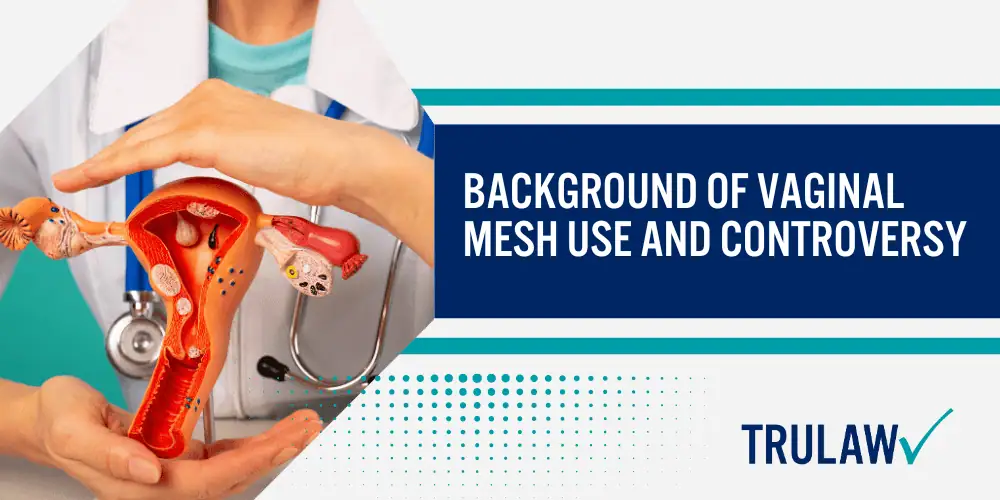
As controversies grew, transvaginal mesh procedures were heavily scrutinized, eventually leading the FDA to mandate more stringent evaluations and eventually ban the use of these meshes in certain procedures by 2019.
Origins and Development of Vaginal Mesh Usage
The development of vaginal mesh technology primarily aimed to improve outcomes for women undergoing surgery for pelvic organ prolapse (POP) and stress urinary incontinence (SUI).
Initially, both biological and synthetic grafts were explored, with synthetic materials gaining traction in the 1990s due to their successful application in hernia repair surgeries.
Vaginal mesh, introduced in the late 1990s, promised to provide durable support for the vaginal structure, reducing the recurrence rate of these conditions.
Over time, surgical mesh became a routine choice for these procedures, driven by evidence suggesting better durability and efficacy when compared to tissue repair alone.
Key historical milestones in vaginal mesh development include:
- The use of synthetic materials in surgery dates back to the 1960s.
- Synthetic grafts became prevalent for POP and SUI repair in the 1990s.
- The FDA categorized vaginal mesh as a class III procedure in 2014, requiring rigorous testing.
- By 2019, the FDA banned certain transvaginal mesh products.
Despite their initial promise, vaginal meshes developed complications and safety became a significant concern.
The rigid synthetic materials sometimes led to severe side effects, notable among them being chronic pain, erosion of the mesh into surrounding tissues, and infections.
The rate and severity of these complications resulted in heightened public and regulatory scrutiny, leading to the FDA’s involvement and decision to require stricter clinical trials and follow-up studies.
This regulatory shift marked a turning point in how transvaginal mesh products were developed and deployed in medical practice.
Early Indications of Problems with Vaginal Mesh
Concerns about vaginal mesh complications emerged not long after their introduction, as early adopters began reporting adverse symptoms.
Problems like mesh erosion, where the mesh protrudes into the vaginal wall or other organs, were alarmingly frequent.
Women experienced chronic pain, infections, and sometimes debilitating pelvic floor muscle issues, necessitating further surgeries.
Such reactions prompted medical practitioners to question the safety profile of these devices, thereby beginning a closer evaluation of their risks versus benefits.
Common early complications associated with vaginal mesh include, but are not limited to:
- Mesh erosion into adjacent organs
- Chronic pelvic pain
- Recurring infections
- Mesh contraction leading to nerve damage
- Pain during sexual intercourse
- Other serious health complications
These complications led to increased awareness and eventual legal action against mesh manufacturers.
Patients sought legal recourse due to the lack of adequate warnings and labeling about potential side effects.
Surgeons and medical experts highlighted the need for improved patient education on the risks of mesh implantation.
Over time, this advocacy and documentation of adverse effects influenced healthcare policy, culminating in stern regulatory actions and a significant number of lawsuits from affected patients.
Complications and Risks Associated with Vaginal Mesh
Vaginal mesh, primarily used in surgeries for pelvic organ prolapse and stress urinary incontinence, has been linked to significant complications, triggering numerous lawsuits.
The complications related to these implants have resulted in over 100,000 lawsuits, many of which have been resolved by settlements.
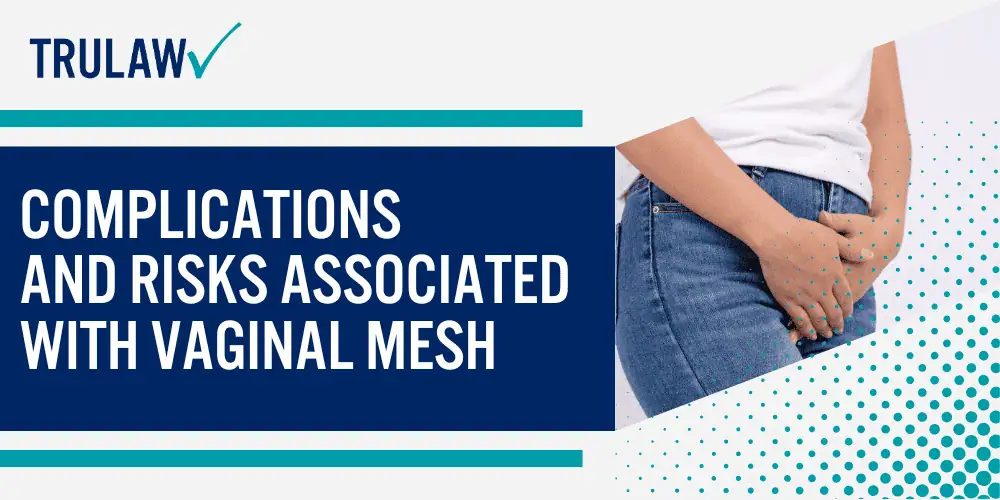
Despite the initial purpose of these medical devices to support weakened pelvic tissue, they often lead to more harm than benefit due to adverse effects such as erosion, pain, and infection.
This situation underscores the importance of understanding both the immediate and long-term risks involved with these devices.
Common Adverse Effects and Injuries
Vaginal mesh implants are associated with several adverse effects, many of which contribute to significant patient discomfort and serious health issues.
The most commonly reported problems include mesh erosion or exposure, which can lead to infection or additional surgical interventions.
Patients often experience chronic pain, bleeding, and organ perforation, all contributing to a decreased quality of life.
Due to these complications, the use of vaginal mesh has become a subject of scrutiny, and patients are seeking legal recourse for these injuries.
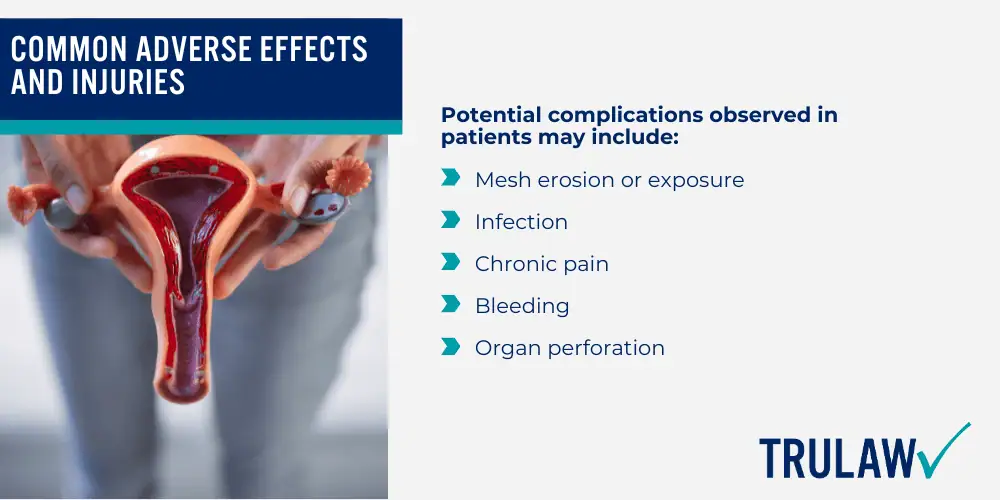
Potential complications observed in patients may include:
- Mesh erosion or exposure
- Infection
- Chronic pain
- Bleeding
- Organ perforation
These complications often necessitate further medical procedures to address the issues caused by the initial implantation of the mesh.
Corrective surgeries not only aim to manage the adverse effects but also strive to restore the quality of life for the affected individuals.
However, the risk of recurrent complications persists even after medical interventions.
Many patients end up suffering long-term physical and emotional distress, which underscores the gravity of these adverse effects.
Long-term Consequences of Vaginal Mesh Implantation
The long-term consequences of vaginal mesh implantation can be profound and far-reaching, affecting many aspects of a patient’s life.
Over time, patients have reported issues such as chronic pain, urinary problems, and psychological distress stemming from their initial surgery.
These problems can develop as a result of the mesh degrading or causing ongoing reactions with the body’s tissues.
This potential for adverse long-term outcomes was a significant factor in the flood of lawsuits filed by affected patients.
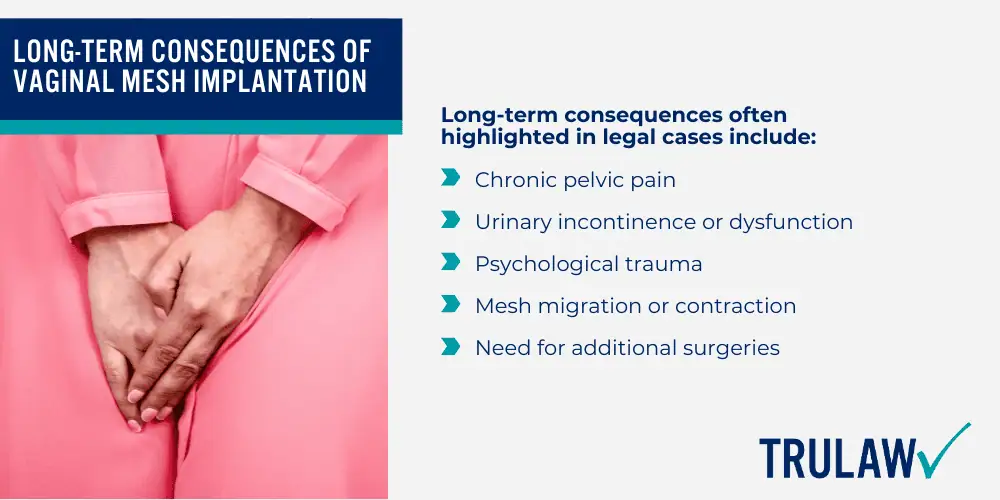
Long-term consequences often highlighted in legal cases include:
- Chronic pelvic pain
- Urinary incontinence or dysfunction
- Psychological trauma
- Mesh migration or contraction
- Need for additional surgeries
Managing these long-term consequences often requires a multi-disciplinary approach involving surgical, psychological, and physical therapies.
The chronic nature of some of these conditions can lead to ongoing medical treatment and significant financial and emotional burdens for patients.
The high volume of litigation reflects a growing awareness and acknowledgment of the severe and lasting impacts of vaginal mesh implantation.
Addressing these issues requires concerted efforts from medical practitioners, regulatory bodies, and legal systems to better protect patients in the future.
Regulatory Actions and Public Awareness
In 2025, regulatory actions concerning transvaginal mesh continued to focus on ensuring patient safety and awareness of potential risks.
The FDA has played a crucial role in classifying and issuing warnings about the use of transvaginal mesh, owing to complications and injuries reported over the years.
This has led to increased scrutiny and a push for more stringent regulations to manage the risk associated with these medical devices.
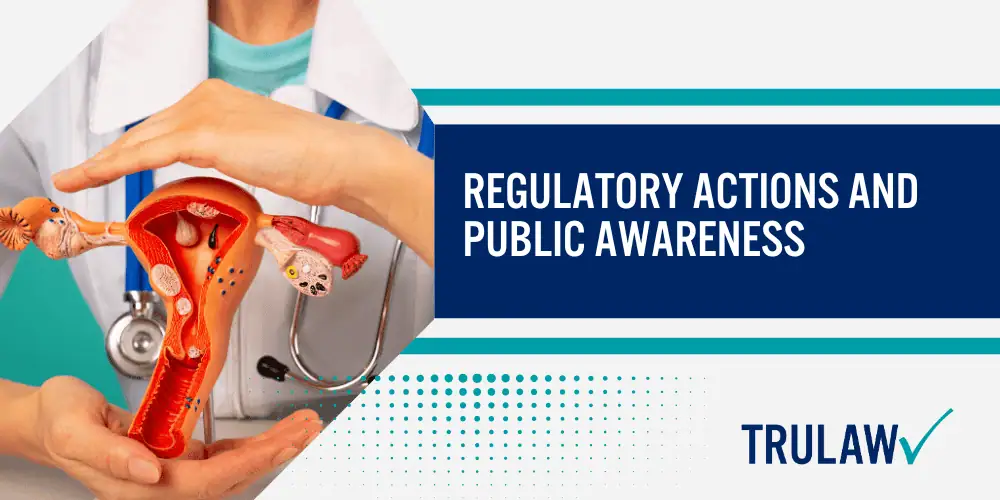
Simultaneously, public awareness and concern have grown, partially due to media coverage that highlights the ongoing legal battles and substantial settlements awarded to affected women.
The combination of regulatory oversight and public discourse underscores the significant impact of transvaginal mesh issues on both the legal and healthcare landscapes.
FDA Warnings and Safety Alerts
The FDA has consistently issued warnings and safety alerts regarding transvaginal mesh due to the significant number of complications associated with its use.
Over time, the FDA has reclassified vaginal mesh devices to reflect their high-risk nature, mandating stringent controls and premarket approval.
This heightened regulatory oversight highlights the associated risk factors, such as erosion, pain, and infection, that have been reported by many women.
In recent years, there have been calls for comprehensive evaluations before their commercial release to mitigate adverse outcomes, exemplifying a shift towards more cautious medical device governance.
FDA regulatory actions to mitigate risks may include, but are not limited to:
- Reclassifying transvaginal mesh from moderate-risk to high-risk.
- Issuing specific safety warnings and guidelines.
- Mandating premarket approval and comprehensive clinical trials.
These measures are intended to enhance patient safety and ensure that only thoroughly evaluated products are available on the market.
The FDA’s stringent approach aims to reduce the incidence of adverse events by fostering a robust regulatory framework.
This has encouraged manufacturers to develop safer alternatives and emphasizes the importance of informed patient consent.
Through continued vigilance and responsive measures, the FDA strives to protect public health while supporting innovation in medical devices.
Growing Public Concern and Media Coverage
Public awareness of transvaginal mesh complications has increased substantially, largely driven by extensive media coverage and the dissemination of lawsuit verdicts.
Many media outlets have highlighted the plight of affected women, showcasing stories of significant physical and emotional distress.
Such coverage has amplified public concern, prompting many to call for greater transparency and stricter regulations from healthcare providers and device manufacturers.
The overlap of legal issues with everyday healthcare experiences has led to a broader discourse around medical accountability and patient rights.
Key factors contributing to public concern typically include:
- High-profile lawsuits and verdict announcements.
- Media stories of patients’ adverse experiences.
- Calls for stronger regulatory actions and healthcare transparency.
The public’s growing concern underscores the importance of effective communication between healthcare providers and patients regarding the risks and benefits of medical devices.
It also spotlights the media’s role in influencing public perception and holding entities accountable for their actions.
This collective awareness and advocacy can potentially catalyze change, leading to improved medical standards and practices.
As the conversation around transvaginal mesh continues, it becomes increasingly clear that informed patient choices and robust regulatory systems are crucial to fostering trust in healthcare.
Eligibility Criteria to File a Transvaginal Mesh Lawsuit
In 2025, transvaginal mesh lawsuits continue to be a significant legal avenue for those who have suffered from complications due to these medical devices.
Eligibility to file a lawsuit is often contingent upon specific criteria, such as experiencing severe complications like mesh erosion, infection, or pain after the mesh implantation.
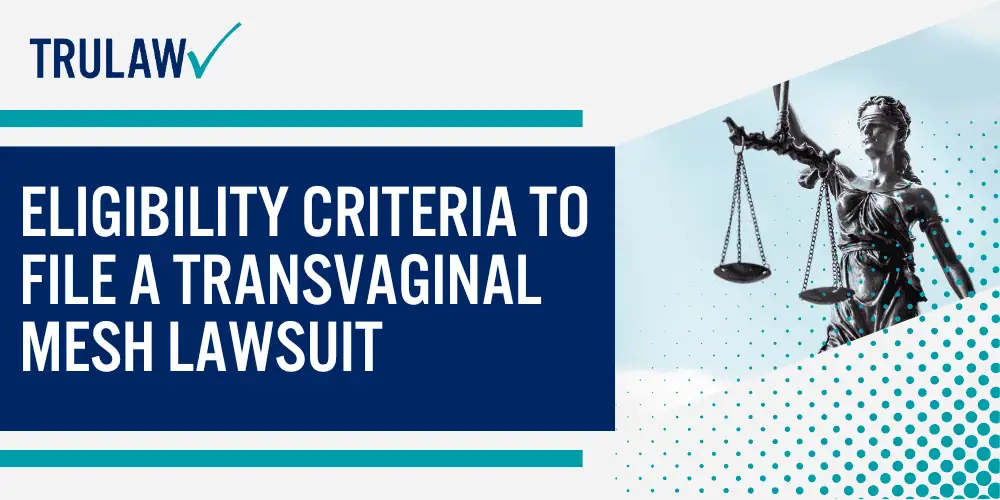
These lawsuits aim to hold manufacturers accountable for providing defective products that have jeopardized patients’ health.
Criteria for Filing a Vaginal Mesh Lawsuit
Individuals seeking to file a vaginal mesh lawsuit in 2025 must meet certain eligibility requirements to proceed with their claims.
These criteria typically include having experienced significant complications arising from the mesh implant, such as erosion, pain, or infection.
Additionally, the timing of the mesh implantation plays a crucial role, as most lawsuits require that the device was implanted before a specific date, often set as December 31, 2021. Proof of medical complications linked directly to the mesh is necessary to support the claims effectively.
Eligibility requirements may include, but are not limited to:
- Receiving a pelvic mesh implant prior to December 31, 2021
- Experiencing complications such as mesh erosion, infection, or chronic pain
- Documented medical interventions related to mesh complications
Meeting these criteria positions a potential plaintiff to file a lawsuit against the mesh manufacturers, which involves producing evidence of the suffering caused by the defective product.
Legal proceedings often require thorough documentation of medical history, treatments undergone due to mesh complications, and expert testimonies to substantiate claims.
Prospective claimants are encouraged to consult legal professionals to determine their eligibility and the viability of their cases, reinforcing their efforts to secure compensation for the harms endured.
Who Can Participate in Vaginal Mesh Settlements?
Participating in vaginal mesh settlements requires claimants to meet specific criteria similar to those needed for filing a lawsuit.
Claimants must have suffered tangible harm or injury due to the mesh device and been part of previous or ongoing litigation.
These settlements offer individuals an opportunity to receive compensation without undergoing a full trial, often based on negotiated terms reflecting the severity of their injuries and the medical expenses incurred.
Claimants eligible for settlements typically include:
- Individuals with documented mesh-related injuries
- Claimants who were part of prior consolidated lawsuits
- Patients with ongoing medical treatment needs due to mesh complications
Vaginal mesh settlements provide a streamlined resolution for many claimants, offering compensation that reflects both the individual’s injuries and the broader context of their legal actions.
Settlement amounts can vary widely, often depending on the severity of the injuries, the extent of the medical treatments required, and whether the plaintiff was involved in earlier group litigations.
As settlements can provide quicker resolutions than lengthy trials, they remain a favorable option for many plaintiffs seeking justice and financial relief for their suffering.
Manufacturer-Specific Lawsuits and Settlements
Transvaginal mesh lawsuits are a significant legal battle involving numerous manufacturers and their alleged negligence.
These lawsuits, filed by women who have experienced severe health complications, focus on issues such as organ perforation, chronic pain, and sexual dysfunction attributed to these medical devices.
The litigation has evolved into multiple multi-district litigations (MDLs) due to the sheer volume of cases against these companies.
While some manufacturers have reached settlements, litigation continues as new cases are filed, reflecting the ongoing nature of these personal injury claims.
Boston Scientific Vaginal Mesh Lawsuits
Boston Scientific is one of the major manufacturers involved in transvaginal mesh litigation.
Legal actions against the company stem from complications associated with its pelvic mesh products, such as the Obtryx, designed to treat pelvic organ prolapse and stress urinary incontinence.
Many women have reported severe injuries and health complications as a result of these products, leading to numerous lawsuits against Boston Scientific.
These cases have highlighted significant concerns regarding the safety and efficacy of such devices.
Potential settlement amounts and lawsuit details may include:
- Over 100,000 lawsuits filed across various manufacturers.
- Specific cases involve injuries such as organ perforation and chronic pelvic pain.
- Some settlements have resulted in compensation for affected women.
The magnitude of litigation faced by Boston Scientific underscores the pressure on manufacturers to address these safety concerns.
The company has been part of massive class action lawsuits, contributing to the landscape of transvaginal mesh litigations.
Settlements and verdicts in these cases help victims receive compensation for their suffering, although the legal battles continue.
These proceedings not only impact Boston Scientific but also shape the broader regulatory and legal framework governing medical device safety.
Other Manufacturers Involved in Transvaginal Mesh Implant Litigation
Several other manufacturers besides Boston Scientific have been implicated in transvaginal mesh lawsuits.
Companies such as Johnson & Johnson, C.R.
Bard, and Coloplast face similar legal challenges due to the adverse effects of their pelvic mesh products.
These lawsuits allege that the devices are dangerous and have caused significant harm, prompting a host of legal claims.
As of late, more than 100,000 lawsuits have been filed against various manufacturers, each highlighting serious complications tied to their devices.
The following companies are typically involved:
- C.R. Bard: Known for cases involving severe injuries from mesh products.
- Johnson & Johnson: Faces numerous lawsuits for defective mesh devices.
- American Medical Systems: Also a major party in associating litigation.
- Coloplast and Cook Medical: Involved in many pelvic mesh lawsuits.
- Neomedic: Named in lawsuits for mesh-related complications.
The involvement of multiple manufacturers demonstrates the widespread issues associated with transvaginal mesh products.
These companies have paid substantial sums in settlements, reflecting the severity of the claims.
Furthermore, the ongoing litigation against these entities has sparked broader discussions about patient safety and regulatory oversight in the medical device industry.
This wave of lawsuits emphasizes the need for stringent testing and clearer warning labels to prevent similar medical tragedies in the future.
Types of Damages Caused by Surgical Mesh Devices
As of 2025, transvaginal mesh lawsuits have continued to be a critical issue within the legal and medical communities.
The vast majority of these cases have concluded through settlements, with estimates suggesting over $8 billion paid out by manufacturers historically.
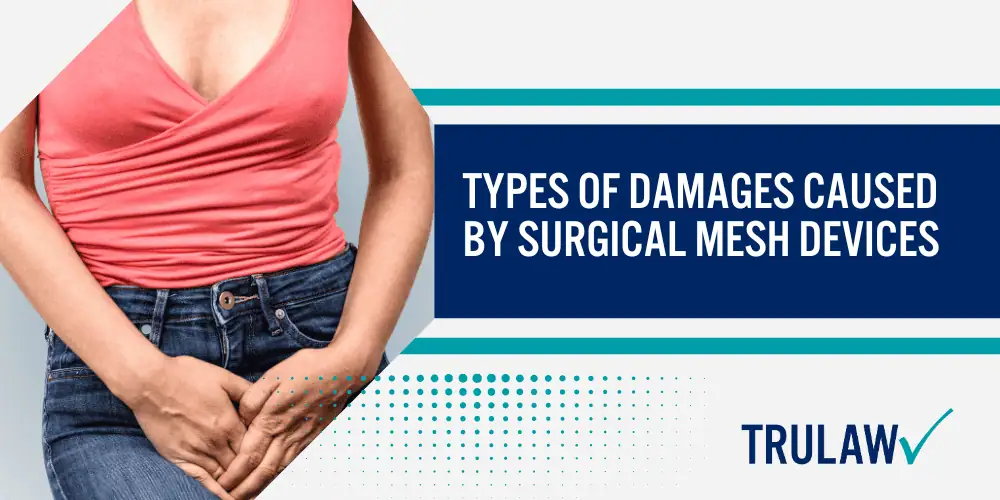
Current speculations propose that new settlements might range from $150,000 to over $400,000 per case, depending on individual circumstances, including the severity of injuries.
These settlements are pivotal in compensating for the suffering and medical costs endured by the claimants.
Vaginal Mesh Settlement Amount Projections for 2025
Projected settlement amounts for transvaginal mesh lawsuits in 2025 are largely influenced by the settlements that have already been achieved in previous years.
With over $8 billion paid in total, individual settlements are anticipated to continue in a substantial monetary range.
Experts suggest that amounts could vary between $150,000 to $450,000 depending on specifics like the individual’s suffering and resultant medical expenses.
These projections highlight the ongoing financial implications faced by manufacturers and underline the potentially significant compensatory relief accessible to victims.
Potential settlement amounts may include, but are not limited to:
- $150,000 on the lower end for minor complications
- $200,000 to $300,000 for moderate medical expenses and pain
- Over $400,000 for severe injuries and extensive medical treatments
Settlement amounts will naturally vary from case to case, factoring in both the physical impact on the plaintiff and the financial burden they have borne.
The wide range between $150,000 and $450,000 reflects the diverse nature of claims, where some cases may involve less severe complications while others require significant ongoing care and financial support.
These compensations play an essential role in addressing the justice and relief sought by plaintiffs, providing a semblance of recovery from the incurred damages.
Factors Affecting Settlement Amounts and Payout Structures
Several dynamics influence the settlement amounts and payout structures for transvaginal mesh lawsuits in 2025.
Key considerations include the severity of the claimant’s injuries, the necessity for corrective surgeries, and the impact of these injuries on their quality of life.
In addition, legal strategies and the jurisdiction where the case is filed can also dramatically affect settlement outcomes.
These factors collectively guide the determination of settlement values, aiming to equitably compensate victims for their suffering and future implications.
The following factors typically include:
- Severity of complications and injuries experienced by the claimant
- Necessity and number of subsequent surgical procedures
- Long-term impact on the individual’s health and lifestyle
- Jurisdictional differences in case outcomes and legal approach
- Preparedness and expertise of legal representation
Each factor is assessed meticulously, and the interplay between them can lead to varied payout structures, even among similar cases.
For instance, a case in one jurisdiction might result in a higher settlement due to precedent or particular court tendencies.
TruLaw: Your Transvaginal Mesh Law Firm
Transvaginal mesh lawsuits are being filed by individuals across the country who were injured by these defective medical devices.
TruLaw is currently accepting clients for the transvaginal mesh litigation.
A few reasons to choose TruLaw for your transvaginal mesh lawsuit include:
- If We Don’t Win, You Don’t Pay: The transvaginal mesh lawyers at TruLaw and our partner firms operate on a contingency fee basis, meaning we only get paid if you win.
- Expertise: We have years of experience handling medical device cases similar to the transvaginal mesh lawsuits, which helps us anticipate what we can expect to see in your case and the regulations we will be required to meet.
- Successful Track Record: TruLaw and our partner law firms have helped our clients recover billions of dollars in compensation through verdicts and negotiated settlements.
If you or a loved one suffered mesh erosion, organ perforation, or other complications after being implanted with a transvaginal mesh device, you may be eligible to seek compensation.
Contact TruLaw using the chat on this page to receive an instant case evaluation that can determine if you qualify for the transvaginal mesh litigation today.
Transvaginal Mesh Lawsuit Frequently Asked Questions
-
Medical literature documents several serious complications arising from transvaginal mesh devices, including erosion through vaginal tissue, organ perforation, and chronic pain.
These adverse events often necessitate revision surgeries and ongoing medical intervention to address both immediate and long-term health impacts.
-
Transvaginal mesh settlement values typically reflect the severity of complications, number of revision surgeries required, and extent of ongoing medical care needed.
Individual compensation amounts vary based on documented medical expenses, impact on quality of life, and specific device manufacturer involvement.
-
Specialists assessing transvaginal mesh surgery outcomes examine factors including mesh erosion, organ damage, infection rates, and chronic pain patterns.
Their evaluations provide crucial documentation for both medical treatment planning and potential legal proceedings.
-
Successful claims typically require comprehensive medical records documenting the initial implant procedure, subsequent complications, and all related medical interventions.
Healthcare providers must maintain detailed documentation of patient symptoms, treatment responses, and ongoing medical needs.
-
Medical teams must carefully evaluate mesh-related complications to determine appropriate intervention strategies.
Revision procedures often involve complex surgical techniques to address mesh erosion, tissue damage, and associated complications while minimizing additional trauma.
-
Healthcare providers implement systematic monitoring programs to track potential complications and address emerging health concerns.
Regular assessments include physical examinations, imaging studies, and evaluation of patient-reported symptoms to ensure appropriate medical management.

Managing Attorney & Owner
With over 25 years of legal experience, Jessica Paluch-Hoerman is an Illinois lawyer, a CPA, and a mother of three. She spent the first decade of her career working as an international tax attorney at Deloitte.
In 2009, Jessie co-founded her own law firm with her husband – which has scaled to over 30 employees since its conception.
In 2016, Jessie founded TruLaw, which allows her to collaborate with attorneys and legal experts across the United States on a daily basis. This hypervaluable network of experts is what enables her to share the most reliable, accurate, and up-to-date legal information with our readers!
Additional Transvaginal Mesh Lawsuit resources on our website:
Here, at TruLaw, we’re committed to helping victims get the justice they deserve.
Alongside our partner law firms, we have successfully collected over $3 Billion in verdicts and settlements on behalf of injured individuals.
Would you like our help?
At TruLaw, we fiercely combat corporations that endanger individuals’ well-being. If you’ve suffered injuries and believe these well-funded entities should be held accountable, we’re here for you.
With TruLaw, you gain access to successful and seasoned lawyers who maximize your chances of success. Our lawyers invest in you—they do not receive a dime until your lawsuit reaches a successful resolution!
AFFF Lawsuit claims are being filed against manufacturers of aqueous film-forming foam (AFFF), commonly used in firefighting.
Claims allege that companies such as 3M, DuPont, and Tyco Fire Products failed to adequately warn users about the potential dangers of AFFF exposure — including increased risks of various cancers and diseases.
Depo Provera Lawsuit claims are being filed by individuals who allege they developed meningioma (a type of brain tumor) after receiving Depo-Provera birth control injections.
A 2024 study found that women using Depo-Provera for at least 1 year are five times more likely to develop meningioma brain tumors compared to those not using the drug.
Suboxone Tooth Decay Lawsuit claims are being filed against Indivior, the manufacturer of Suboxone, a medication used to treat opioid addiction.
Claims allege that Indivior failed to adequately warn users about the potential dangers of severe tooth decay and dental injuries associated with Suboxone’s sublingual film version.
Social Media Harm Lawsuits are being filed against social media companies for allegedly causing mental health issues in children and teens.
Claims allege that companies like Meta, Google, ByteDance, and Snap designed addictive platforms that led to anxiety, depression, and other mental health issues without adequately warning users or parents.
Transvaginal Mesh Lawsuits are being filed against manufacturers of transvaginal mesh products used to treat pelvic organ prolapse (POP) and stress urinary incontinence (SUI).
Claims allege that companies like Ethicon, C.R. Bard, and Boston Scientific failed to adequately warn about potential dangers — including erosion, pain, and infection.
Bair Hugger Warming Blanket Lawsuits involve claims against 3M — alleging their surgical warming blankets caused severe infections and complications (particularly in hip and knee replacement surgeries).
Plaintiffs claim 3M failed to warn about potential risks — despite knowing about increased risk of deep joint infections since 2011.
Baby Formula NEC Lawsuit claims are being filed against manufacturers of cow’s milk-based baby formula products.
Claims allege that companies like Abbott Laboratories (Similac) and Mead Johnson & Company (Enfamil) failed to warn about the increased risk of necrotizing enterocolitis (NEC) in premature infants.
Here, at TruLaw, we’re committed to helping victims get the justice they deserve.
Alongside our partner law firms, we have successfully collected over $3 Billion in verdicts and settlements on behalf of injured individuals.
Would you like our help?
